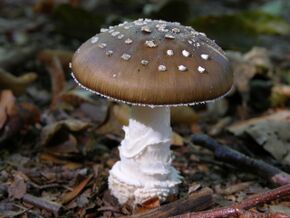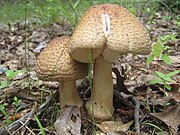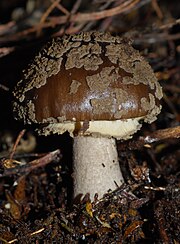Amanita pantherina
| Amanita pantherina | |
|---|---|
|
A. pantherina |
|
| Taxonomical nomenclature | |
| Kingdom | Fungi |
| Phylum | Basidiomycota |
| Class | Agaricomycetes |
| Order | Agaricales |
| Family | Amanitaceae |
| Genus | Amanita |
| Species | A. pantherina |
| Common nomenclature | |
| Common names | Panther cap, false blusher |
| Mycological Characteristics | |
| Spore print | White |
| Constituents | |
| Active constituents | Muscimol , ibotenic acid |
Amanita pantherina, also known as panther cap or false blusher (due to its similarity to the edible mushroom tree blusher), is a psychoactive mushroom in the Amanita genus. The main psychoactive compound in this mushroom is muscimol. The subjective effects of this mushroom, however, are not similar to psilocybin mushrooms.
Toxicity and harm potential

It is important to convert ibotenic acid to muscimol before consumption.
Please read Fly agaric: Ibotenic acid decarboxylation to muscimol to learn how to convert the relatively neurotoxic compound (speculated to be a stimulant[1][2]) ibotenic acid to muscimol.
Also, novel edibles "Amanita Mushroom Gummies" contain a substantial amount of ibotenic acid along with muscimol and muscarine. Given the toxicity of ibotenic acid, the consumption of those preparations even in small doses should be avoided![3]
A 1998 publication listed Muscimol as an Extremely Hazardous Substance (EHS) on the Environmental Protection Agency's (EPA) list. However, a later document from 2006 shows it was removed from the list.
Habitat
The panther cap is an uncommon mushroom, which is found in both deciduous (especially beech) and coniferous woodland. It is rarely found in meadows throughout Europe and western Asia in late summer and autumn. It has also been recorded on Vancouver Island in British Columbia, Canada as well as in South Africa, where it is thought to have been accidentally introduced with trees imported from Europe.
It is an ectomycorrhizal fungus, living in root symbiosis with a tree and deriving photosynthesised nutrients from it while providing soil nutrients in return.
Similar species

Hunting psychoactive mushrooms in nature can be very dangerous.
Caution is advised because poisonous or deadly mushrooms can easily be mistaken for edible ones.

External links
- Legal status of psychoactive Amanita mushrooms (Wikipedia)
- Psychoactive Amanita mushroom (Wikipedia)
- Amanita pantherina (Wikipedia)
- Psychoactive amanitas (Erowid)
- Amanitaceae.org
References
- ↑ Chilton 1975; Theobald et al. 1968
- ↑ Chilton 1975; Ott 1976a
- ↑ https://www.kykeonanalytics.com/news/New-trend-of-Amanita-Mushroom-Gummies-potentially-neurotoxic-edibles/
- ↑ Paulus, W., Bresinsky, A. (1989). "Forest Decline and Air Pollution". In Schulze, E.-D., Lange, O. L., Oren, R. Soil Fungi and Other Microorganisms. 77. Springer Berlin Heidelberg. pp. 110–120. doi:10.1007/978-3-642-61332-6_6. ISBN 9783642647956.


